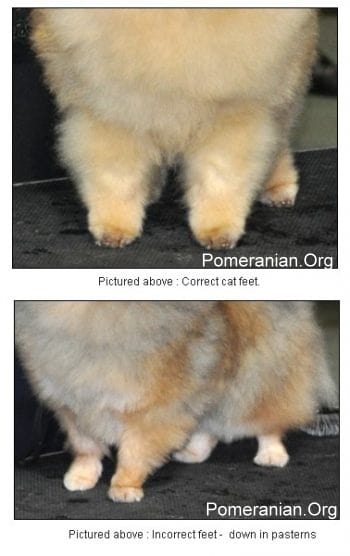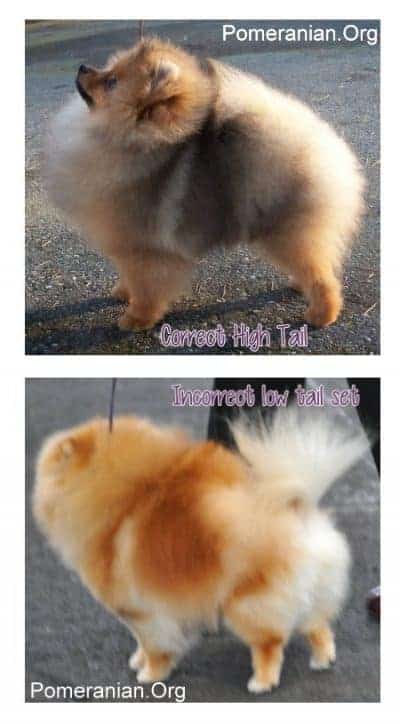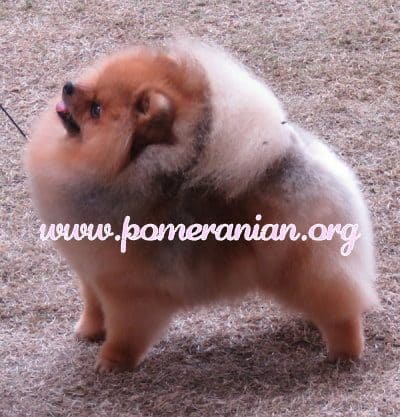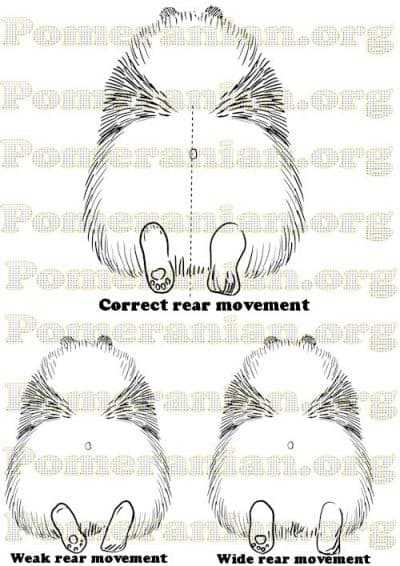Last Updated on April 8, 2022 by Denise Leo
General Appearance
The general appearance is listed first in the standard and is the very first thing noted by the judge at a show. It’s often the only part of a dog that people who are sitting ringside get to see.
The Pomeranian is the smallest member of the Spitz family. A Pomeranian is a small, compact, dainty dog with an abundant coat. His huge, fluffy coat is the perfect match for his over-the-top personality. His crowning glory is a dense, double-coat, made up of long, harsh, standoff guard hairs and a soft woolly undercoat. The Pomeranian’s coat contributes tremendously to the breed’s
visual appeal.

The Pomeranian’s symmetry and balance are in the right proportions to each other, and this is crucial to his overall appearance. His carriage, gait, style and temperament are also factors to be kept in mind.
A perfect Pomeranian should appear to fit into a circle. The Pom has been described as having the appearance of a circle within a square. Another description ( and the description I prefer) is a Pomeranian must be a square within a circle. The square represents the dog’s body. The circle is formed by the Pomeranian’s double coat that’s harsh and in the show ring is trimmed for neatness.
He’s a square breed. His back is short and his ratio of height to body length, at the withers, is 1 to 1. To calculate the proportions, two measurements are taken. The first is from the ground to the highest point of his withers; the second is from his buttocks to his prosternum.
He’s a short backed, compact canine and his cobby body is well rounded. Because of his huge double coat and short back, he seems to be a floating fur ball.

The Pomeranian never limps, hops or sways, instead he seems to float along on tip toes. His neck is short and mounted on well laid shoulders, allowing his head to move along in a high, proud movement.
His tail is set high and straight and flat along his back, and it’s covered by harsh, long spreading hair. The tail’s profuse plume reaches to the back of his head, and the ruff that sits on the top of his skull and tail merge.
A Pomeranian needs a certain amount of leg but he shouldn’t be too short or tall. He must have some leg, but he shouldn’t be too high or too low to ground. He needs to have a well-balanced, symmetrical outline that’s also dainty, glamorous, alert and pretty.
A Pom’s sound body and mind lets him moves properly, and he can hear, see and smell, has the ability to breed and possesses a poised, alert, cooperative disposition.
Despite the Pomeranian’s classification as a toy breed, the words placid and toyish do NOT describe him in any way. He was bred from the Spitz and has the enormous spirit that you would expect from that breed of dog.
The Pom should be so light and dainty on his feet that he seems to dance. He will never develop a coarse tendency. A show Pomeranian needs to be stylish, glamorous, intelligent and outgoing. Whenever he enters the ring, he will be full of life and self-confidence.
Pomeranian Temperament
A Pomeranian is extremely outgoing with plenty of spirit and bounce. He won’t be in the least bit timid or shy and bounces like a ball whenever he hears a sound. He’ll easily match the pace of other dog breeds 10 times bigger than he is. He’s a sound dog with all the right body parts where they are supposed to be and they function as they should.
An ideal Pomeranian possesses an exaggerated sense of his own importance. He’s sure of himself and quite cocky. He’s beautiful with exceptional style and he knows this.
A show Pomeranian needs to be vain enough to show off his beauty to its best advantage. If he doesn’t have this vanity so he can be a show off, it’s as serious a problem as owning a Pom with no good qualities that can be displayed.
Pomeranian Head
The head of a Pomeranian is one of his most distinct features and makes a major contribution to correctness of the specific breed of dog.
The head is wedge-shaped with a short fine muzzle. He has medium sized almond-shaped eyes, tiny pricked ears, and an intelligent sweet expression.The Pomeranian needs the right shape of head and muzzle, as well as a sweet expression. His muzzle shouldn’t be dish faced or downfaced.

A Pomeranian’s head must be in proportion to the dog’s body and any exaggerations are incorrect. An ideal Pomeranian head is wide behind the jaw graduating to a fine muzzle. An incorrect long muzzle means the essential wedge won’t exist and the Pomeranian will have a German Shepherd look. If his muzzle is too short, the muzzle will resemble that of a Chihuahua.
The Pom’s skull is slightly flat and shouldn’t be shaped like a round dome. Pomeranians that have a lot of dense head coat can give the impression their heads are rounder than desired. Lightly run your fingers over his skull to learn what his head really is shaped like. His head should have a moderate stop.
The descriptive word “foxy” in the outline describes the expression of a fox with extreme intelligence and a look of innocence. Even though his head needs to be foxy in his outline, he doesn’t need to have a fox’s long pointed muzzle If the Pom’s muzzle is long, he has a snipey sharp look.

As a standard guideline: From the tip of the nose to the stop and from the stop to the back of the head will measure 1:2 in most Pomeranians. The stop is dog terminology for the small indentation between a dog’s eyes.

Pomeranian Eyes
A Pomeranian’s eyes are almond shaped, medium-sized and dark in colour. If the Pom’s eyes aren’t the correct almond shape, he loses that distinct Pom expression.
When evaluating the size of a Pomeranian’s eyes, consider the total size of the dog. If his eyes appear too small for his head, he’ll have beady eyes and a cunning expression. If they’re too big, he’ll resemble an owl; yet another negative feature.
Pomeranian Ears
Small ears should be positioned high on the head. The Pomeranian’s ear placement can’t be too high, nor can the ears be too tiny. A Pomeranian’s ears are generally covered by short hair that is trimmed to make him look better. If his ears are set correctly, it gives an alert, intelligent expression that is highly valued in this particular breed.
Mouth
His teeth meet in what’s described as a scissor bite, where his top incisors sit just in front of his bottom teeth. A Pomeranian’s mouth must never be wry, overshot or undershot. These faults are inherited and cause a major problem in this breed.

In a wry mouth, neither set of teeth are set square in his jawline. This causes his mouth to look twisted and sometimes his tongue will be protruding out and to one side. Pomeranians are prone to losing teeth while young.
In an overshot mouth, the Pom’s upper jaw protrudes a long way over his lower jaw…often giving him a snipey sharp look.

If he has an undershot mouth, it’s the lower jaw that protrudes over his upper jaw, sometimes making his expression seem ugly and aggressive.
Neck
A Pomeranian’s neck needs to be short and sitting well into his shoulders, so he can carry his head high and proud. If he moves with his head forward and down, it ruins his complete outline and balance, making it seem as though it’s stretched.
Pomeranian Forequarters
A Pomeranian’s are laid well back, sloping back so the point of the withers sits a little bit higher than the line from the back. Each shoulder blade and upper arm are usually the same length (or close to it). His elbows sit well in his sides. The tips of his toes and his throat has to be in a perfect straight line.

Pomeranian Hindquarters
From his side, the buttocks sit way behind the tail. If you view him from the rear, his legs should be straight and parallel.

Pomeranian Feet
The Pomeranian’s feet must be small, compact and resemble a cat’s paws with strong, straight pasterns. Standing well up on his toes, his compact feet point straight ahead.

Long thin feet with spreading toes or down on the pasterns are undesirable.
When trimmed the feet should look like an extension of the legs with only small definition.
Body
The ideal silhouette of a Pomeranian depicts a stylish, compact, well-balanced, sturdy, dainty small dog.
His back has to be short. His barrel is well-rounded and his well-sprung ribs provides enough space for his lungs and heart. The Pomeranian is short coupled and his well-ribbed body goes to a short loin.
A Pomeranian possesses a deep brisket and well-developed chest. His body has lots of substance and is very well defined.
Serious faults such as long couplings and slab side bodies spoil the Pom’s shape, type and outline.
Pomeranian Tail
The tail is a unique characteristic of the breed. It’s profusely covered with long, harsh, straight hair and should be carried high and flat over the back. Check the tail set by positioning the palm of your hand up against the dog’s rear. If the tail set is correct, a hard bone won’t be felt.

If the tail is set extremely low, it will sit in an upward “circle” shape. If the root of his tail has a twist, it will fall to the side instead of lying flat, regardless of the height of the set and plume. It should never fall or curl to the side. A low set tail spoils the Pomeranian’s outline.

Pomeranian Coat
A Pomeranian’s coat is a major characteristic. It had the highest amount of points during early breed standards. Despite the quantity of his coat being essential, it’s also vital that it has a correct texture. His double coat has to be luxurious. The Pomeranian’s coat must meet the quality and quantity correctness for the breed’s ideal appearance.
A Pomeranian’s coat has two parts: the top coat is straight, long and harsh. His undercoat is dense and soft. His thick undercoat causes his outer hair to stand out from the body, making him look like a little puffball. His coat is heaviest on the front part of his shoulders, chest and neck, whereas his head and legs have
the shortest hair.
As a Nordic breed, the requirements of a harsh double coat should never be ignored. A soft, cotton type coat is undesirable on an adult Pomeranian. A Pom puppy’s coat may be dense and shorter and may (or may not) show guard hair.
The Question of Pomeranian Trimming
When done the right way, trimming can provide a stylish look and outline. However, you should never be able to compare a Pom to a clipped hedge or a trimmed bichon or poodle.
Trimming certainly has its value. If a Pomeranian hasn’t been trimmed, he virtually has zero chance in any show ring. A properly-trimmed Pom won’t look fake; he will be well-groomed and neat in appearance.
Pomeranian Size
The Pomeranian ideally weighs 4 to 5 pounds (1.8 to 2.5 kg) but may weigh 3 to 7 pounds. In contrast to most dog breeds, the female Pomeranian is preferred to be larger than the male.
Females have an essential role to play in the future of the Pomeranian breed. They must be sound, have substance and be absolutely suitable for breeding. Pomeranians experience their share of whelping difficulties. Breeding with larger females is encouraged in the hope of decreasing whelping complications.
Oversize and undersize are serious flaws. If the dog is oversize, he can lose the dainty look and type common to the breed. He may also have a kind of coarseness.
If he’s undersize, he may start losing some of his coat, body and soundness. He may look weedy and lacking in substance.
Pomeranian Movement
The Pomeranian has a smooth, balanced, vigorous gait. He possesses good reach in his forequarters, with strong drive in his hindquarters. The front leg extends forward in a straight line, with his opposite rear leg taking the same action.

Each rear leg will move at the same time as the front leg on the opposite side. To keep balanced, his legs will slightly converge inwards to a centre line under his body. As he moves, none of his legs are thrown out or in. His topline stays level and he maintains his outline and balance.


Pomeranian Colours and Patterns
All whole colours permissible, but free from black or white shadings.
Whole colours are: white, black, brown, blue, orange, beaver, cream. Shaded sables and parti-coloured dogs.
Detailed information on Pomeranian Colours and Patterns as accepted by the Australian National Kennel Council breed standard.
The colour section of the breed standard:
” All whole colours permissible, but free from black or white shadings. Whole colours are: white, black, brown, light or dark, blue as pale as possible. Orange which should be self-coloured and bright as possible, Beaver. Cream dogs have black noses and black eye rims. Whites must be quite free from lemon or any other colour. A few white hairs in any of the self-coloured dogs permissible but undesirable. Dogs (other than white) with white or tan markings highly undesirable and not considered whole coloured specimens. In parti-coloured dogs, colours evenly distributed on body in patches; a dog with white or tan feet or chest not a parti-coloured dog. Shaded sables should be shaded throughout with three or more colours, the hair to be as uniformly shaded as possible, and with no patches of self-colour. In mixed classes, where whole coloured and parti-coloured Pomeranians compete together, the preference should, if in all other points they are equal, be given to the whole coloured specimens. “
N.B. Part of this article was first published on the Pomeranian Headquarters Website and is reproduced here with written consent of the author.
Copyright Denise Leo, Pomeranian Headquarters©. All Rights Reserved.
References and Further Reading:
[1] Leo, Denise. “Pomeranian Dog Breed Information.” Pomeranian Headquarters.
[2] Denise Leo, The Pomeranian Handbook.
[3] Official Standard of the Pomeranian (AKC). American Kennel Club, 2011.
[4] English Kennel Club Pomeranian Breed Standard,2017.
[5] ANKC Pomeranian Breed Standard.
The Pomeranian Handbook
( Printed and shipped in Australia).


